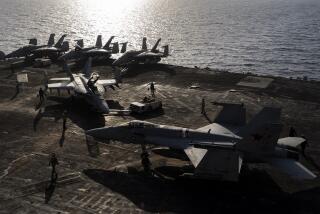Cheney Targets Major Bases in State to Close
WASHINGTON — The Defense Department has prepared an extensive list of military bases it plans to close or consolidate in the United States and overseas, including several major California installations, military and congressional sources said Thursday.
Among the California facilities slated for closure are the Long Beach Naval Shipyard and the Army’s Ft. Ord, near Monterey, Pentagon sources said.
The list, although not final, targets scores of large and small facilities across the country and is certain to set off a clamorous debate as Congress begins to wrestle with a new defense budget that begins to fundamentally alter the nation’s military posture.
In Orange County, Marine Corps air bases in El Toro and Tustin and the Seal Beach Naval Weapons Station do not appear to be earmarked for closure, according to aides to Reps. Robert K. Dornan and C. Christopher Cox. Though they have not seen the list, the aides said that there have been no indications that any local bases are targeted.
Defense Secretary Dick Cheney will formally present the list of proposed base closures on Monday when he introduces the $295-billion Pentagon budget proposal for the 1991 fiscal year beginning in October. Pentagon officials cautioned that final shape of the base closure proposal will depend to some extent on discussions set for this weekend with members of Congress and officials of allied governments overseas.
The Navy proposed to close the Long Beach Naval Shipyard, which employs about 5,000 military and civilian workers in reconditioning Navy ships, as well as the Navy’s major East Coast shipyard in Philadelphia. Defense analysts estimate that closing the Long Beach shipyard could save the Navy an estimated $8 million a year. The Long Beach Naval Station was not proposed for closure.
Also on the Navy’s hit list are a number of relatively small naval air stations from Oakland to South Weymouth, Mass.
The list of Army installations alone contains 126 facilities, Army sources said Thursday, including Ft. Ord, home of the Army’s 7th Infantry Division. Army planners propose to move the entire division to Ft. Lewis, in Washington state. The 9th Infantry Division and its large support staff, based at Ft. Lewis, would be sharply cut back, Army sources said.
“It’s dead,” said an Army official, who added that Ft. Ord’s “lousy” training area and the cost of living in the area were critical factors in the Army’s decision to move the unit.
Ft. Ord employs more than 15,000 military personnel and 1,800 civilian workers, making it one of Monterey County’s major employers.
In addition, the Army has proposed to shutter several Army depots, including several in Central California. Those installations are small enough that Cheney is not required to seek congressional approval for the moves.
The Navy apparently has targeted a number of San Francisco Bay area facilities for closure or major manpower reductions. Included are the Treasure Island Naval Station in San Francisco, the Alameda Naval Air Station, the Oakland Naval Supply Center, the Oakland Naval Hospital and Oak Knoll Naval Hospital in Oakland.
The five Northern California installations together have a payroll of $900 million, employing 21,000 servicemen and 11,000 civilians, and their closure could cause an economic loss to the areas of up to $3.8 billion, a Pentagon source said.
Some of the Army’s largest and best-known military bases are slated for closure or significant troop cuts, Army officials said Thursday. The Army has proposed to close Ft. McClellan, Ala., and is recommending manpower cuts at Ft. Knox, Ky.; Ft. Hood, Tex.; Ft. Rucker, Ala.; Ft. Benning, Ga.; Ft. Benjamin Harrison, Ind., and Ft. Bragg, N.C.
One of two divisions based at Ft. Hood, the 2nd Armored Division, which is dedicated for use in the defense of Western Europe, has been slated for complete demobilization by 1992, Army officials said.
The Army base closures are part of a larger plan to restructure the nation’s largest military service to accommodate shrinking budgets and a reduced threat from the Soviet Union and the disintegrating Warsaw Pact.
“These bases are superfluous to our needs,” said one Army officer. “Two years ago the Army looked out into its future and started planning for a smaller Army. We’re now embarked on a course for change to maintain readiness in the near term and the long-term to deploy a deployable and lethal Army by 1995. This is absolutely part of that.”
Over the next four years, the Army proposes to cut troop strength by 135,000, from the current level of about 760,000 men and women. The plan calls for reducing European deployments under arms agreements with the Soviets and for reshaping U.S.-based units into a lighter, fast-reaction force for use in contingency operations around the globe.
The Navy, Air Force and Marines have proposed smaller troop cuts but have offered to forgo a number of expensive weapons systems in order to meet their share of budget reductions Cheney has proposed. A comprehensive list of facilities that these services are proposing to close or consolidate was not available Thursday.
But sources in Congress confirmed that the Navy has proposed closing the Philadelphia Naval Shipyard, a major shipbuilding and repair center employing 29,000 military and civilian workers. Rep. Thomas M. Foglietta, (D-Pa.) has scheduled a press conference for Friday to protest the plan to close the shipyard.
More to Read
Get the L.A. Times Politics newsletter
Deeply reported insights into legislation, politics and policy from Sacramento, Washington and beyond. In your inbox three times per week.
You may occasionally receive promotional content from the Los Angeles Times.











